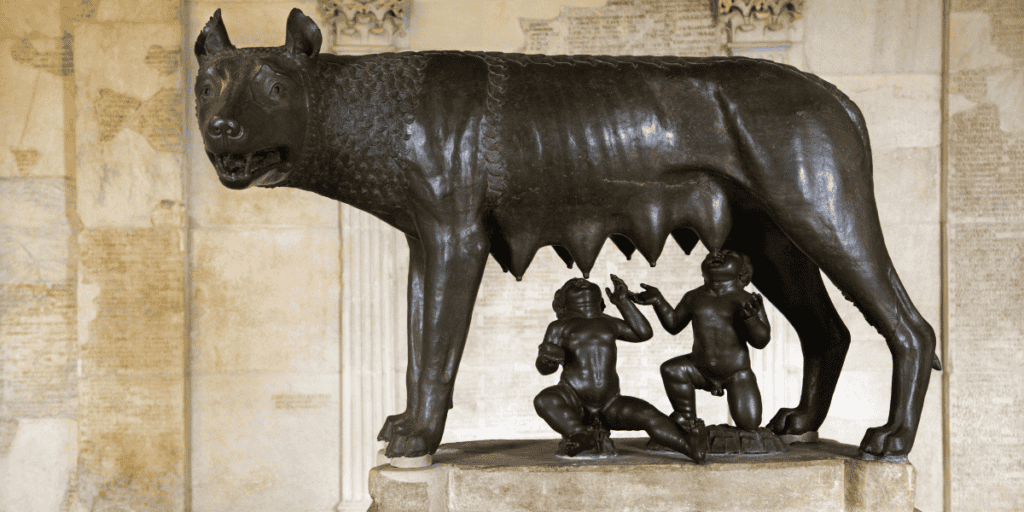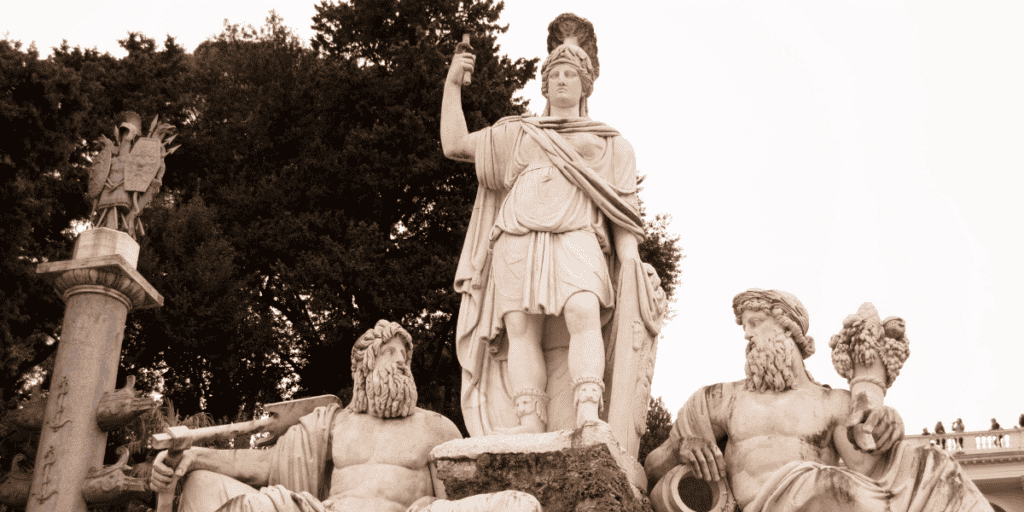Roman mythology tells stories of Roman gods, goddesses, demi-gods, and heroes. Roman mythology postdates its Greek mythology predecessor, as some of the best Roman myths may not exist without Greek myths to help shape them.
The culture of the modern day Italians was deeply influenced by Roman mythology.
Not only that, but the powerful Roman Empire built its foundation using the powerful myths and legends of the people.
Let’s take a look at some of them.
The Myth of Romulus and Remus

Romulus and Remus were twin brothers who were descendants of the Roman hero, Aeneas.
Their mother was Rhea Silvia, a vestal virgin who had taken a vow of chastity to watch over the hearth in honor of the Roman goddess of the hearth, Vesta. Because she was a virgin, the conception of Romulus and Remus has different variations.
One legend says that Mars, the god of war, lay with Rhea Silvia, while other myths say that Hercules lay with her.
When she betrayed her vow of chastity, she should have been ordered to be killed, per the laws.
Instead, the twins were taken to be killed by a servant who decided to spare their lives by floating the twins down the River Tiber.
The river god, Tiberinus, carries them to safety. One day, a shepherd and his wife discovers the twins and raises them to be shepherds.
The Founders of Rome

One day, the shepherds of the king who ordered them to be killed engaged in a fight with the twins.
Remus was apprehended and taken to the king to be imprisoned. Romulus devised a plan with the other shepherds to rescue his brother.
When he arrived, Romulus helped Remus escape from the prison and killed the king in the process. The citizens asked Romulus and Remus to rule the city, but they refused to seek and civilize a city of their own.
This is How Rome was Founded
Romulus and Remus began to establish their own cities. Romulus built his city on the Palatine Hill while Remus built his city on the Aventine Hill.
They continued fighting until, one day, Romulus began digging a trench around his city and ultimately constructed a wall that surrounded his city.
Remus would ridicule the wall that Romulus built, and when the ridicule was not enough, he decided to jump over the wall that Romulus built.
Unfortunately, Remus was killed after jumping over the wall. Grief-stricken Romulus buried his brother and decided to name his city Rome.
Romulus instituted a Roman government, and the population of his city began to grow. For years, Rome was successful. They survived their first battle with the help of Jupiter, the god of thunder. Once victorious, Rome continued to their success and used war and invasion to grow their empire.
Without the birth of Romulus and Remus and their fateful destiny to compete for the best city, Rome would have likely never been founded, which is what makes this Roman myth so important to the Roman culture.
The Myth of Jupiter and the Bee
The Roman myth of the bee is one that has been told for centuries and still rings true today. The myth of the bee teaches us about the consequences that come with seeking revenge on someone.
There was once a great beehive that produced the sweetest honey. Mortals would visit the beehive and take the honey the bees had made. One day, the queen of the beehive flew up to Mount Olympus to visit Jupiter, the god of the sky. Knowing
that she needed to offer Jupiter something in return for a favor, she took some of the honey with her.
Once reaching Jupiter, she offered him the honey, to which he gladly accepted.
Just as the queen bee predicted, Jupiter offered to fulfill any wish for her, to which she replied that she wanted to be equipped with a stinger that will allow her to protect her honey from the mortals who stole it.
She wanted the ability to inflict injury upon anyone who attempted to steal the honey from this moment forward.
Jupiter agreed but gave her a warning that if she used her stinger, it would break off and remain in the wound that she created and result in her own death.
He explained that using this stinger would be a risk to her own life.
The queen bee listened to Jupiter’s warning about the risk to her life, but she had already decided that protecting the honey and the beehive was worth the risk.
This Roman myth teaches us that seeking revenge on someone who does us wrong can have deadly consequences.
The Myth of Pluto and the River Stix
Pluto is the god of death and the ruler of the underworld. When one would die, they would be sent to the underworld to remain with Pluto.
Separating the living world from the underworld was the River Styx.
In order to enter the underworld, your soul had to cross the River Styx.
When crossing the river, a boatman named Charon would appear to carry you to the underworld, but you must remit payment for the ride; otherwise, he would leave you, and you would be stuck between the land of the living and the underworld.
To pay the boatman, you must be buried with a coin in your mouth, and then he would take you to the other side of the river.
Today, the dwarf planet Pluto is named after the Roman god of the underworld because of its extremely cold conditions. Pluto’s main moon is named Charon after the boatman of the River Styx.
The Myth of Hercules and the 12 Labors
One of the most famous Roman myths is Hercules and his 12 labors. This myth is popular in both Greek and Roman mythology. Roman mythology discovered Hercules through Greek art and began to tell the stories of his labors.
Hercules had to complete 10 difficult and seemingly impossible labors because he had murdered his family and was indebted to making the wrong he had done right.
In doing so, he became enslaved to a king who made him complete 10 labors in hopes that he would die in the process.
These are the 12 labors of Hercules:
1. Hercules and the Nemean Lion

There was a lion who lived in Nemea and had golden fur that could not be penetrated with typical weapons because the fur was so thick. Hercules lured the lion into a cave and hit it with a club. Hercules skinned the golden fur by using one of the claws of the lion and then returned the golden hide to the king.
2. Hercules and the Lernean Hydra
There was a hydra who lived in the lake of Lerna. Hercules defeated the hydra with the help of a family member, to which the king said that this labor did not count as one of the 10 labors he needed to complete on his own.
Therefore, Hercules would have to do another labor in its place.
3. Hercules and the Ceryneian Hind
The Ceryneian hind was a female deer that Hercule had to capture.
While the deer was female, it had golden antlers, which is what made it so rare and so special. Hercules chased the deer for an entire year before finally capturing it and presenting it before the king.
4. Hercules and the Erymanthian Boar
The Erymanthian Boar was an extremely large wild pig. Hercules captured the boar by chasing it into the snow and using a net to capture it.
He then took the boar back to the king.
5. Hercules and the Augean Stables
Hercules had to clean the Stables of the King Augean for his 5th labor.
It is known that the powerful hero was not only strong, but smart as well.
He devised a plan to clean the stables in one day, just as the king requested, by digging trenches to route the river to flow into the stables.
During this labor, Hercules was compensated by King Augeas, who owned the stables.
6. Hercules and the Stymphalian Birds
There was a flock of birds that terrorized a nearby city, so the king ordered Hercules to drive out the flock. Hercules received noisemakers from the gods to help drive the birds out.
7. Hercules and the Cretan Bull
Hercules had to travel to Crete to bring back a large bull. Hercules wrestled the bull to the ground and brought it back to the king, who decided to let the bull go back into the wild.
8. Hercules and the Mares of Diomedes
The mares of Diomedes were large horses that Hercules was ordered to capture and bring back to the king. In the process, Hercules killed Diomedes and founded the city of Abdera.
When he brought the mares back to the king, the king set them free.
9. Hercules and the Belt of Hippolyta
Hippolyta was the queen of the Amazon, and her belt was made of leather and given to her by the Greek god of war, Ares. Hercules killed Hippolyta and took her belt back
to the king.
10. Hercules and the Cattle of Geryon
Hercules was ordered by the king to bring him the cattle of Geryon for his 10th labor. Hercules was able to capture the cattle and bring them to the king, where he
gave them to Hera, the queen of the Greek gods.
11. Hercules and the Apples of the Hesperides
The king ordered Hercules to bring him the golden apples that belonged to Zeus, the Greek god of the sky. With help, Hercules was able to retrieve the golden apples and bring them back to the king. Because these apples belonged to the gods, the king had to return them.
12. Hercules and Cerberus
The final labor of Hercules was to kidnap Cerberus, the three-headed dog that guarded the underworld. Hercules found Pluto, the Roman god of the underworld, and told him why he was there.
Pluto told Hercules he could have Cerberus if he could overpower him with his strength alone.
Hercules succeeded and took Cerberus to the king, where he was eventually returned by the king to the underworld.
Conclusion
We often forget how much of an influence the Romans have on our culture.
The Roman myths and legends remain popular to this day and have inspired many books and films.
What’s your opinion of Roman Mythology? Comment below!
